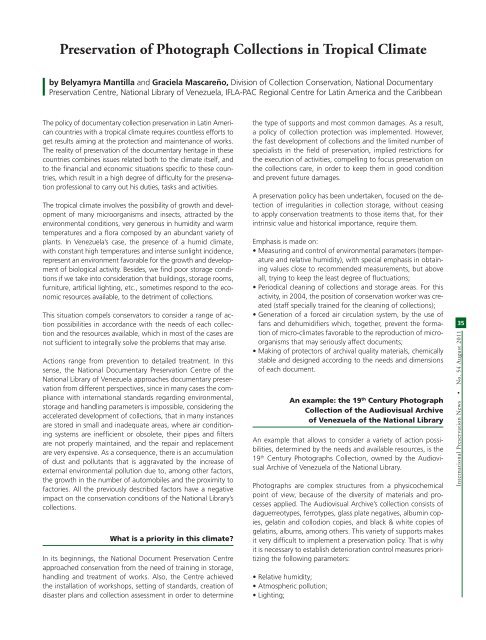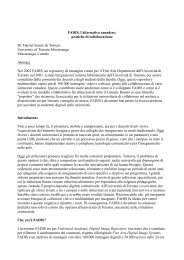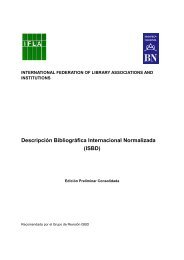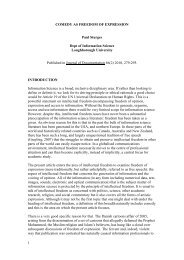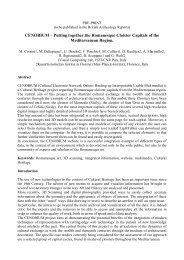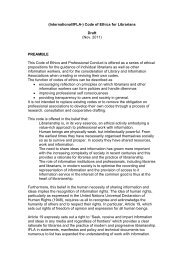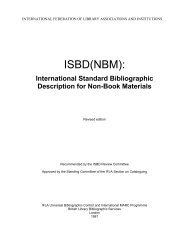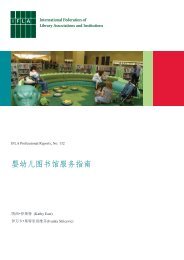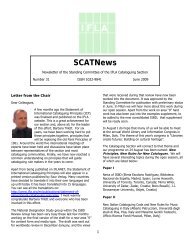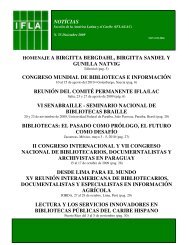N o 54 - IFLA
N o 54 - IFLA
N o 54 - IFLA
Create successful ePaper yourself
Turn your PDF publications into a flip-book with our unique Google optimized e-Paper software.
Preservation of Photograph Collections in Tropical Climate<br />
by Belyamyra Mantilla and Graciela Mascareño, Division of Collection Conservation, National Documentary<br />
Preservation Centre, National Library of Venezuela, <strong>IFLA</strong>-PAC Regional Centre for Latin America and the Caribbean<br />
The policy of documentary collection preservation in Latin American<br />
countries with a tropical climate requires countless efforts to<br />
get results aiming at the protection and maintenance of works.<br />
The reality of preservation of the documentary heritage in these<br />
countries combines issues related both to the climate itself, and<br />
to the financial and economic situations specific to these countries,<br />
which result in a high degree of difficulty for the preservation<br />
professional to carry out his duties, tasks and activities.<br />
The tropical climate involves the possibility of growth and development<br />
of many microorganisms and insects, attracted by the<br />
environmental conditions, very generous in humidity and warm<br />
temperatures and a flora composed by an abundant variety of<br />
plants. In Venezuela’s case, the presence of a humid climate,<br />
with constant high temperatures and intense sunlight incidence,<br />
represent an environment favorable for the growth and development<br />
of biological activity. Besides, we find poor storage conditions<br />
if we take into consideration that buildings, storage rooms,<br />
furniture, artificial lighting, etc., sometimes respond to the economic<br />
resources available, to the detriment of collections.<br />
This situation compels conservators to consider a range of action<br />
possibilities in accordance with the needs of each collection<br />
and the resources available, which in most of the cases are<br />
not sufficient to integrally solve the problems that may arise.<br />
Actions range from prevention to detailed treatment. In this<br />
sense, the National Documentary Preservation Centre of the<br />
National Library of Venezuela approaches documentary preservation<br />
from different perspectives, since in many cases the compliance<br />
with international standards regarding environmental,<br />
storage and handling parameters is impossible, considering the<br />
accelerated development of collections, that in many instances<br />
are stored in small and inadequate areas, where air conditioning<br />
systems are inefficient or obsolete, their pipes and filters<br />
are not properly maintained, and the repair and replacement<br />
are very expensive. As a consequence, there is an accumulation<br />
of dust and pollutants that is aggravated by the increase of<br />
external environmental pollution due to, among other factors,<br />
the growth in the number of automobiles and the proximity to<br />
factories. All the previously described factors have a negative<br />
impact on the conservation conditions of the National Library’s<br />
collections.<br />
What is a priority in this climate?<br />
In its beginnings, the National Document Preservation Centre<br />
approached conservation from the need of training in storage,<br />
handling and treatment of works. Also, the Centre achieved<br />
the installation of workshops, setting of standards, creation of<br />
disaster plans and collection assessment in order to determine<br />
the type of supports and most common damages. As a result,<br />
a policy of collection protection was implemented. However,<br />
the fast development of collections and the limited number of<br />
specialists in the field of preservation, implied restrictions for<br />
the execution of activities, compelling to focus preservation on<br />
the collections care, in order to keep them in good condition<br />
and prevent future damages.<br />
A preservation policy has been undertaken, focused on the detection<br />
of irregularities in collection storage, without ceasing<br />
to apply conservation treatments to those items that, for their<br />
intrinsic value and historical importance, require them.<br />
Emphasis is made on:<br />
• Measuring and control of environmental parameters (temperature<br />
and relative humidity), with special emphasis in obtaining<br />
values close to recommended measurements, but above<br />
all, trying to keep the least degree of fluctuations;<br />
• Periodical cleaning of collections and storage areas. For this<br />
activity, in 2004, the position of conservation worker was created<br />
(staff specially trained for the cleaning of collections);<br />
• Generation of a forced air circulation system, by the use of<br />
fans and dehumidifiers which, together, prevent the formation<br />
of micro-climates favorable to the reproduction of microorganisms<br />
that may seriously affect documents;<br />
• Making of protectors of archival quality materials, chemically<br />
stable and designed according to the needs and dimensions<br />
of each document.<br />
An example: the 19 th Century Photograph<br />
Collection of the Audiovisual Archive<br />
of Venezuela of the National Library<br />
An example that allows to consider a variety of action possibilities,<br />
determined by the needs and available resources, is the<br />
19 th Century Photographs Collection, owned by the Audiovisual<br />
Archive of Venezuela of the National Library.<br />
Photographs are complex structures from a physicochemical<br />
point of view, because of the diversity of materials and processes<br />
applied. The Audiovisual Archive’s collection consists of<br />
daguerreotypes, ferrotypes, glass plate negatives, albumin copies,<br />
gelatin and collodion copies, and black & white copies of<br />
gelatins, albums, among others. This variety of supports makes<br />
it very difficult to implement a preservation policy. That is why<br />
it is necessary to establish deterioration control measures prioritizing<br />
the following parameters:<br />
• Relative humidity;<br />
• Atmospheric pollution;<br />
• Lighting;<br />
35<br />
International Preservation News • No. <strong>54</strong> August 2011


